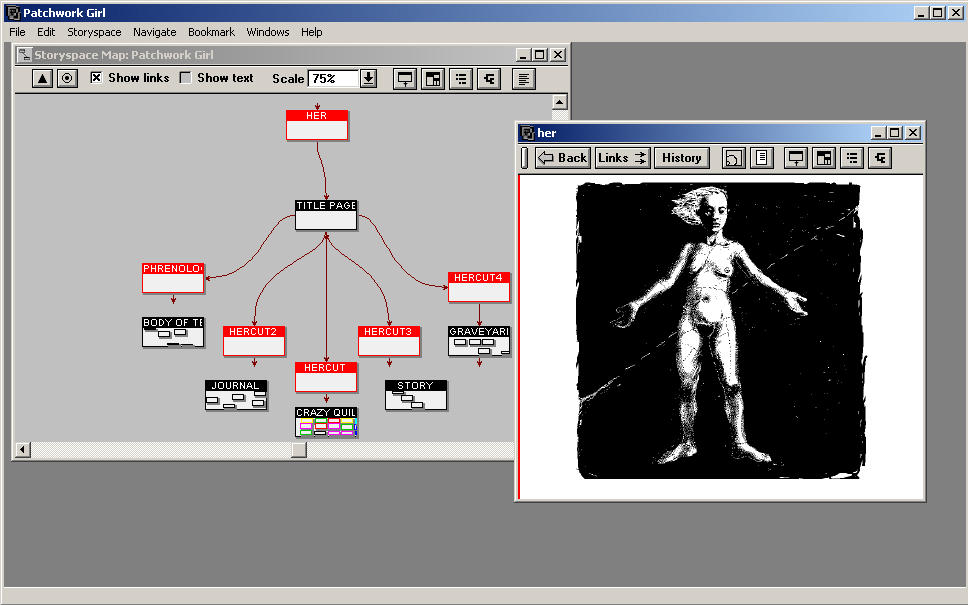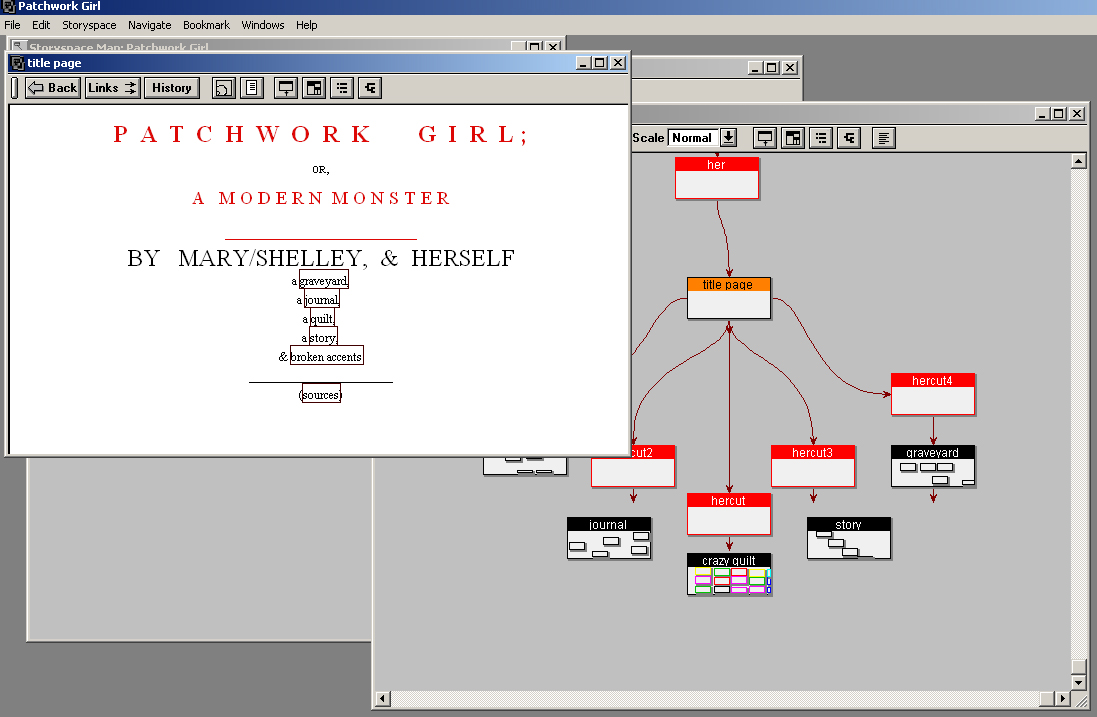Literature, Arts and Media 2017-18
|
Literature, Arts and Media 2017-18
|
|
|
ELECTRONIC LITERATURE
ELO Electronic Literature Collection 1 --- 2 ---- 3
Shelley Jackson, My Body - a WunderkammerSara Rossetti, MM Metromind
Heavy Industries, Dakota
Brian Kim Stefans, The Dreamlife of Letters
Camille Utterback & Romy Achituv, Text Rain
Noah Wardip-Fruin - Screen Installation >>from youtube: https://www.youtube.com/watch?v=WOwF5KD5BV4
Andrew Ellis and Students at the Dynamic Media Institute, ReMap
Shelley Jackson, Snow
Emma Lozano Doogan, Gioia Vavricka, Alex Dornauer, White Bird in a Blizzard + instagram account
Electronic Literature Organization’s definition of electronic literature says “works with important literary aspects that take advantage of the capabilities and contexts provided by the stand-alone or networked computer.”
Lori Emerson: e-literature is “what did not exist until the founding of the Electronic Literature Organization in 1999. [... It] is a name, a concept, even a brand with which a remarkably diverse range of digital writing practices could identify (...).”
"an emerging cultural form" (Tabbi 2007)
electronic vs digital literature
digital literature “ is simply media distributed and /or experienced using a computer, rather than digital media".
- hypertext fiction, hypernovels, hyperpoetry, hyperfiction
- interactive fiction
- cyber-literature, cyber-poetry, ergodic literature
- "codework," textual software art (code poetry)
- generative art
- Flash poem, flash generation texts
- network fiction, net literature
- installation pieces, software-controlled electronic text-based installation art
- locative narratives
- text-based computer games
- experiential writing in digital media, physio-cybertext ...
machine language = an interface between hardware and text, which we can extend to include operating systems, applications and a variety of software widely shared all over the world to allow global communication; secondly, a
verbal language = cooperates with equally shared multimedia and multimodal languages of communication
First generation: 1987-1995 Hyperfiction - mainly USA; Storyspace and Eastgate Systems; Joyce, Bolter and Bernstein +France: generative poetry by Balpe and animated poetry by Papp
Second Generation, or web 1.0 (1995-2004): multimodal opportunities offered by the web
Third Generation or web 2.0 or cybernetic literature (2004 – oggi): social network, app for mobile devices, virtual reality, augmented reality
Main features:
• data
• process
• interaction
• surface
• context
process-intensive-program
vs
data-intensive-program
technology >> techno-logic
- Ipertesto: lexias or conceptual spaces [Shalley Jackson, My Body o Patchwork Girl] > topographic writing
- cybertesto: ergodic, event + perplexia [Talan Memmott, Lexia to Perplexia]
- database: layer [Norman klein, Bleeding Through the Layers of los Angeles]
- physio-narrative: reading and writing as physical/sensorial experience; [Physio-cybertext, cave writing; augmented reality]
- transmedia storytelling/socialmedia storytelling/ mediastorytellling: engagement (clouds; tag)
Christopher Strachey
Combinatory Love Letters (1952)
Apart from the beginning and the ending of the letters, there are only two basic types of sentence. The first is "My—(adj.)—(noun)—(adv.)—(verb) your—(adj.)—(noun)." There are lists of appropriate adjectives, nouns, adverbs, and verbs from which the blanks are filled in at random. There is also a further random choice as to whether or not the adjectives and adverbs are included at all. The second type is simply "You are My—(adj.)—(noun)," and in this case the adjective is always present. There is a random choice of which type of sentence is to be used, but if there are two consecutive sentences of the second type, the first ends with a colon (unfortunately the teleprinter of the computer had no comma) and the initial "You are” of the second is omitted. The letter starts with two words chosen from the special lists; there are then five sentences of one of the two basic types, and the letter ends "Yours (adv.) M.U.C.." (26-27)
Here is an example :
JEWEL JEWEL
MY HEART IS WEDDED TO YOUR WISH. MY ADORABLE YEARNING FONDLY CHERISHES YOUR KEEN CHARM. MY PRECIOUS RAPTURE PASSIONATELY LONGS FOR YOUR BEAUTIFUL AMBITION. YOU ARE MY TENDER LUST. MY YEARNING CLINGS TO YOUR PASSION.
YOURS IMPATIENTLY
M. U. C.
net.art generator (1999) di Cornelia Sollfrank http://www.digicult.it/digimag/article.asp?id=127
1960 inventore Joseph Weizenbaum all’MIT crea Eliza/Doctor un computer text generator
http://chayden.net/eliza/Eliza.html
esempio:
>> Hello.
How do you do. Please state your problem.
>> what is the weather?
Why do you ask ?
>> because i am sad
Is that the real reason ?
>> yes it is
You seem to be quite positive.
>> not at all
I'm not sure I understand you fully.
>> don't worry
Please go on.
>> i need to know about the weather today
What would it mean to you if you got to know about the weather today ?
>> i change my shoes
Your shoes ?
>> yes
You are sure.
>> yes
I see.
>> and you?
We were discussing you -- not me.
>> sorry
Please don't apologise.
>> I am curious
Is it because you are curious that you came to me ?
>> yes
I understand.
>> no
Are you saying no just to be negative?
>> yes
You seem to be quite positive.
>> no
You are being a bit negative.
>> yes
You are sure.
>> no
Why not ?
>> i am sad
I am sorry to hear that you are sad.
>> don't worry
Lets discuss further why your shoes .
BOT:
Noah Wardrip-Fruin, Impermanente agent:
"The story of software agents begins with the idea of a 'soft robot' - capable of carrying out tasks toward a goal, while requesting and receiving advice in human terms. In recent years, a much narrower marketing fantasy of the agent has emerged, with a relationship to actual agent technologies as tenuous as Robbie the Robot's relationship to factory robots, and it grows despite failures such as Microsoft Bob. Now we often see agents as anthropomorphized, self-customizing virtual servants designed for a single task: to be a pleasing interface to a world of information that does not please us."
BOT http://collection.eliterature.org/3/collection-bots.html >> Short for robot, a bot is a computer program designed to operate autonomously, performing scheduled, responsive, or real-time operations in a computer, through the Internet, and/or on social media networks. What distinguishes bots from other kinds of software is that they interact with and/or produce content for humans, often assuming a human persona.
John Cayley, windsound
hypertext
Storyspace
Così scrive Micheal Joyce:Our program, Storyspace, originated as an attempt to develop a text-processing tool to enable writers of interactive presentations to exploit multiplicities. Storyspace depends on a decisional order rather than a fixed order of presenting material. (…) A decisional order, however, may be thought of as a series of locales, some of which are linked by linear progression or argument, but with others that are determined by allusiveness, resemblance, evocation, or unexplained or “intuitive” parallels determined as often by the author as by the reader. (…) Not long after I first met Stuart Moulthrop, I remember asking him, in all seriousness, “Do you ever find yourself wanting to press the words on a page of a book you’re reading to see what’s behind them?” [M. Joyce, Of Two Minds. Hypertext Pedagogy and Poetics, The University of Michigan Press, Ann Arbor (Michigan) 1998, p. 95.]
“Electronic writing is both a visual and verbal description”, says Bolter, “not the writing of a place, but rather a writing with places, spatially realized topics […] signs and structures on the computer screen that have not easy equivalent in speech.” For Bolter, hypertext’s “electronic symbols […] seem to be an extension of a network of ideas in the mind itself.” Storyspace, the hypertext system Bolter and I developed with John B. Smith, embodies Bolter’s view that the “topographical” writing of hypertext” reflects the mind as a web of verbal and visual elements in conceptual space.


Cybertext e Codework
Espen Aarseth, Cybertext, Perspectives on Ergodic Literature : “Cybertext is a machine for the production of variety of expression: texts can be added by reader, generated differently from initial materials, or in which connections between texts can change in different states of the work.”
Talan Memmott, Lexia to Perplexia
database:"Archivio elettronico di dati organizati secondo una determinata struttura", oppure un "insieme di informazioni tra loro omogenee strutturate logicamente, così da potere essere ordinato e consultato secondo criteri diversi"
database in senso informatico: una raccolta strutturata di dati che risultano essere facilmente e velocemente accessibili all’utente.
“a new metaphor that we use to conceptualize individual and collective cultural memory, a collection of documents or objects, and other phenomena and experience.” [Lev Manovich, The Language of New Media]
Indeed, if after the death of God (Nietzsche), the end of grand Narratives of Enlightment (Lyotard), and the arrival of the Web (Tim Berners-Lee), the world appears to us as an endless and unstructured collection of images, texts, and other data records, it is only appropriate that we would want to develop a poetics, aesthetics and ethics of this database. [Lev Manovich, The Language of New Media]
“Making narratives is a strategy for making our world of experiences and desires intelligible. It is a fundamental way of organizing data.” [E.Branigan, Narrative Comprehension and Film]
Bleeding Through Layers of Los Angeles
In this way, ever-different connections and variations of the
story are generated –similar to flashes of memory that connects
with other memories or influences. The viewers wander through
this memory landscape as if through a city, turning to the right
and then to the left, attracted by new elements that pop up on
the edge of their field of vision.[11 A.Kratky, “How to navigate Forgetting” in N.Klein, Bleeding Through.,p.61]
"We're a civilization of layers," Klein says. "We no longer think
in montage and collage; we multitask in layers more and more.
(…) When we walk along the street we have multitasking
phones and electronics." The computer desktop is another
example of that layering as is the ticker of news that scrolls
across the bottom of TV broadcasts.
Kate Pullinger, Stefan Schemat and babel, The Breathing Wall
programma di Writing Digital Media della Brown University
Noah Wardrip-Fruin, Robert Coover, Joshua J. Carroll, Shawn Greenlee, Andrew McClain, Screen
http://www.youtube.com/watch?v=WOwF5KD5BV4
http://www.youtube.com/watch?v=dSLChcV_a3o&feature=relatedBruno Nardeau, Still Standing (2005) bodies as reading instruments + reading is a fundamentally embodied activity
@ElliottHolt's #TwitterFiction Story: Was it a suicide? A homicide? Or an accident? Read and decide....
Davide Pedrazzini, https://twitter.com/emj1900 + https://twitter.com/drgwhite8
Augmented Reality: http://www.paolacarbone.com/storytelling/2017/AR-17.htm
- to write directly over the world
- interplay of complex surfaces
- space is actually “penetrated by discourse”
Amaranth Bursuk and Brad Bouse, Beetween Page and Screen
.
https://vimeo.com/18632284 Chinatown from dynamicmediainstitute.org
The World Park Interactive Museum @ New York's Central Park
Street Museum's London map http://www.museumoflondon.org.uk/Resources/app/you-are-here-app/home.html
Honey Nut Cheerios Honeyway Train Augmented Reality game by Boffswana for Saatchi & Saatchi NY
https://www.ceros.com/blog/vr-storytelling-5-explorers-defining-next-generation-narrative/
holoportation: https://www.youtube.com/watch?v=7d59O6cfaM0
Locative Narratives:
Blast Theory (UK), Jeremy Hight (USA), Janet Cardiff (Canada), Chris Caines (Australia) and Paul Carter (Australia)
https://vimeo.com/18632284 Chinatown from dynamicmediainstitute.org
JEREMY HIGHT, JEFF KNOWLTON, AND NAOMI SPELLMAN , 34 North 118 West or http://34n118w.net/34N/
Megan Heyward, Notes for Walking + videos
Bing | Decode Jay-Z Case Study https://www.youtube.com/watch?v=XNic4wf8AYg
FANFICTION > popular net literature > www.fanfiction.net